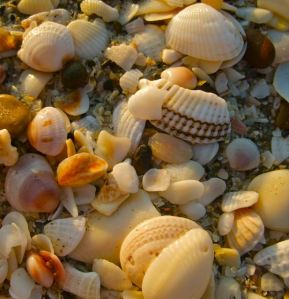Posted on October 7, 2012 by Bob Berwyn
Shellfish are expected to be hit hard by ocean acidification in the coming decades.

Bob Berwyn photo.
CO2 from decaying algae blooms adds to ocean woes
By Summit Voice
SUMMIT COUNTY — Runoff from agricultural and urban areas is speeding up ocean acidification in some coastal areas, adding to the woes resulting from increased concentration of atmospheric carbon dioxide.
A new study by researchers with the National Oceanic and Atmospheric Administration and the University of Georgia found that CO2 released from decaying algal blooms intensifies acidification, which is already taking a toll on shellfish populations in some areas.
Ocean acidification occurs when the ocean absorbs carbon dioxide from the atmosphere or from the breakdown of organic matter, causing a chemical reaction to make it more acidic. Species as diverse as scallops and corals are vulnerable to ocean acidification, which can affect the growth of their shells and skeletons.
The study suggests that, given current atmospheric CO2 concentrations and projected CO2 released from organic matter decay, seawater acidity could nearly double in waters with higher salinity and temperature, and could rise as much as 12 times current levels in waters with lower salinity and lower temperature.
The study found that, that, given current atmospheric CO2 concentrations and projected CO2 released from organic matter decay, seawater acidity could nearly double in waters with higher salinity and temperature, and could rise as much as 12 times current levels in waters with lower salinity and lower temperature.
NOAA’s William G. Sunda and Wei-jun Cai of the University of Georgia found that eutrophication — the production of excess algae from increased nutrients, such as, nitrogen and phosphorus — is large, often overlooked source of CO2 in coastal waters. When combined with increasing CO2 in the atmosphere, the release of CO2 from decaying organic matter is accelerating the acidification of coastal seawater.
The effects of ocean acidification on the nation’s seafood industry are seen in the Pacific Northwest oyster fishery. According to NOAA, ocean acidification is affecting oyster shell growth and reproduction, putting this multi-million dollar industry at risk. Annually, the Pacific Northwest oyster fishery contributes $84 million to $111 million to the West Coast’s economy. According to an earlier NOAA study ocean acidification could put more than 3,000 jobs in the region at risk.
Sunda and Cai used a new chemical model to predict the increase in acidity of coastal waters over a range of salinities, temperatures and atmospheric CO2 concentrations. They found that the combined interactive effects on acidity from increasing CO2 in the atmosphere and CO2 released from the breakdown of organic matter were quite complex, and varied with water temperature, salinity and with atmospheric CO2.
“These interactions have important biological implications in a warming world with increasing atmospheric CO2,” said Sunda. “The combined effects of the two acidification processes, along with increased nutrient loading of nearshore waters, are reducing the time available to coastal managers to adopt approaches to avoid or minimize harmful impacts to critical ecosystem services such as fisheries and tourism.”
These model predictions were verified with measured acidity data from the northern Gulf of Mexico and the Baltic Sea, two eutrophic coastal systems with large temperature and salinity differences, which experience large-scale algal blooms. The observed and modeled increases in acidity from eutrophication and algal decay are well within the range that can harm marine organisms.
Funding support for the research came from the National Science Foundation, NASA and NOAA. The study can be found in this month’s edition of the American Chemical Society’s Environmental Science and Technology journal.
Special thanks to Craig Quirolo